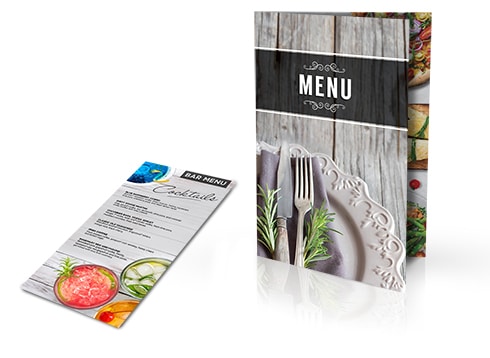
You know the feeling. Your stomach is grumbling, you’re on the cusp of hangry, and you sit down at a restaurant looking around for a menu. The server tells you that you need to scan the QR code, but you either don’t have your phone, the page is taking too long to load, or the sheer size of the menu just isn’t digestible (pun intended) on your tiny phone screen.
While digital menus made sense at the height of the pandemic to reduce the spread of the COVID-19 virus, they’re not a sustainable, long term alternative for customers. Some phones don’t have the functionality to read QR codes, and digital menus aren’t always accessible for people with visual impairments. In fact, a Time Out poll found that nearly 70% of respondents want paper menus to return.
Whichever side of the menu debate you sit on, it’s undeniable that physical menus add a certain something to the dining experience and enable establishments to brand themselves in a more unique way. Here’s why we think it’s time to bring back printed menus, and how to do so in style.
Printed Menus vs QR Code Menus
The Printing for Less team all agree that printed menus offer a little “je ne sais pas” to eating and drinking out. According to Account Executive, Kristi Eby, “even though I’m perfectly capable of looking on my phone, I prefer a printed menu. There’s just something about it.”
Fellow Account Executive, Zach Rinehart agrees, “I don’t like QR codes, and a lot of the older population doesn’t like them either,” he says. “A physical menu is a tactical experience – whereas when you scan a QR code, it doesn’t always load right away which can be frustrating. With a printed menu, it’s immediate, and it’s rooted in the restaurant environment.”
There’s also the matter of politeness. Amy Auble, X our eCommerce Marketer, points out that when you sit down at a restaurant and have to use a QR code, you’re spending time in front of your phone, not talking to the people you’re with. Digital menus can therefore feel like they force people to be rude and disengage from the conversations in front of them. With a printed menu, however, you don’t get that same feeling because it’s less intrusive than staring at a screen.
A Shift Back to Physical Menus
Beyond being more user friendly, print menus are also an opportunity for brands to showcase their personality. Brooke Seidel, our Quad Lead, suggests that companies can add information about the business, their story, and fun facts. Often, digital menus don’t have the same space for these extras, and are made from design templates, so don’t carry the same level of customization.
In particular, physical menus that have a distinct touch resonate in smaller locations. For example, Zach believes that paper menus will make a comeback in Montana. Kristi adds that only a few places in Bozeman still use QR codes, compared to around 80% of places that have gone back to printed menus.
At Printing for Less, we’ve already seen a noticeable uptick in the number of businesses requesting printed menus again – and we celebrate it!
Designing the Perfect Printed Menu
With printed menus back on the rise, companies should seize the moment to refresh their menu’s aesthetic. Zach recommends incorporating features like soft touch, coil binding, spot UV, and other effects to enhance photos and the paper durability. UV coating tends to be more standard than a gloss finish because it better protects the pages from any spills or wear and tear.
Brooke notes that some menus use offset folding too, where there’s one main fold but then a smaller flap within the menu to highlight drinks, appetizers, and extras. “A menu is one of the first things you see when you walk into a restaurant,” Brooke explains. “You sit down, you’re greeted by the server, and handed the menu. What you hold in your hand needs to embody the rest of the restaurant and brand.”
Nathan goes further, noting that “aside from a customer’s meal, the menu is the most tactical element of dining out. The menu should therefore be an extension of the business. If you have a cheap looking menu, customers will have lower expectations about your food. Just think about what you’d expect from a takeout menu versus a restaurant menu. They’re different for a reason.”
Still, businesses that opt to print their menus in bulk need to be aware of quantity, Zach adds. “The biggest issue we run into with menus is the order volume. Typically, businesses order 50 menus, but if you want a menu with special features like smart flex, or extra large in size, you’ll have to meet minimum quantity orders. At Printing for Less, that’s 250, as we can’t print in small quantities unless it’s a coil bound menu.”
In summary: long live the printed menu. We’re envisioning a world where we go out for food, taste-buds ready, and get to feel our way through the menu. If, like us, you’re hungry for 100% in-person dining again, check out our menu printing features.
